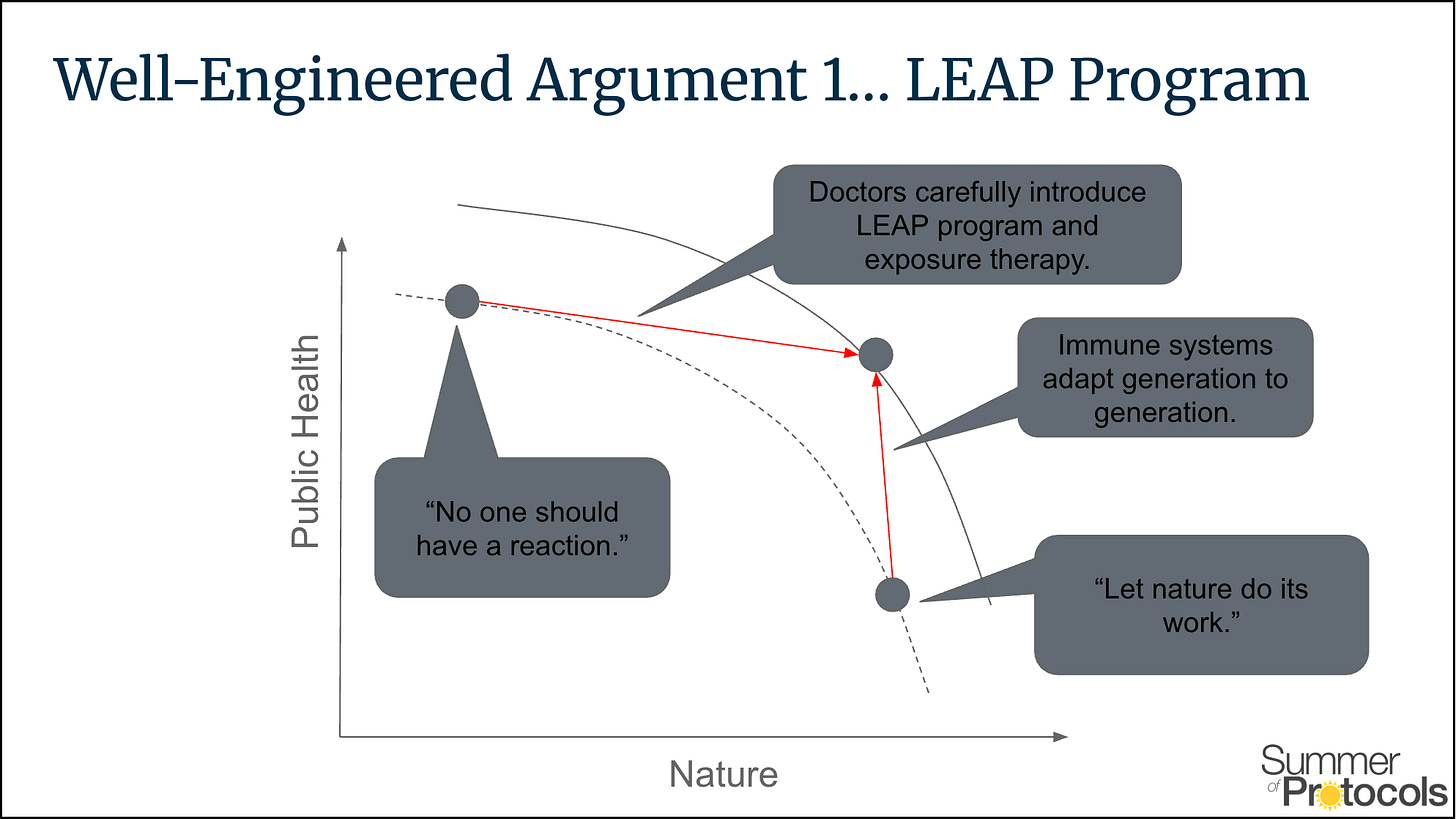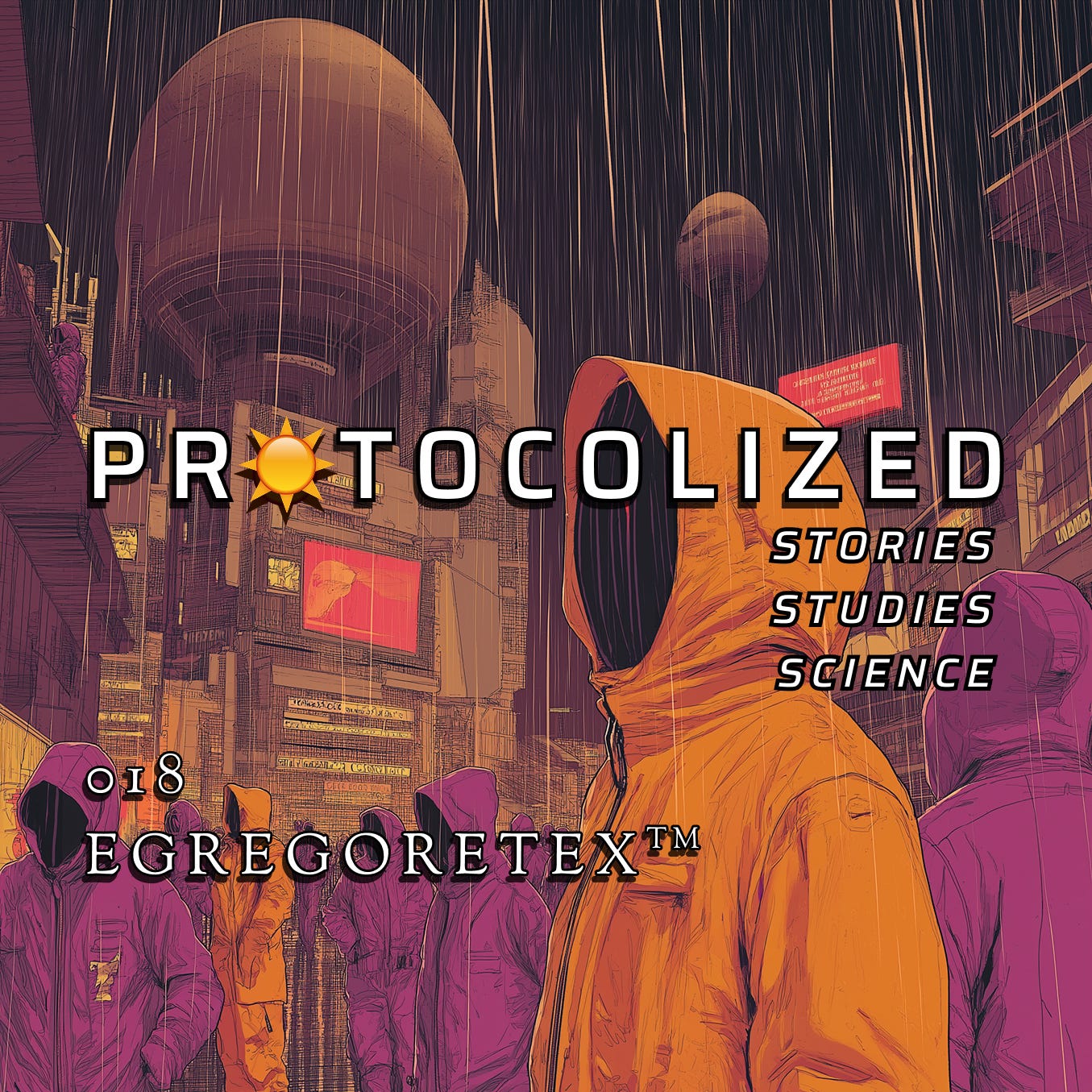EGREGORETEX™️
Issue #18: Neural defenses, transparent wood, and more news
In this issue: A Canadian design lab navigates the risks – and opportunities – posed by the widespread adoption of brain-computer interfaces in a world inhabited by metamegafauna. Also, an important update on tomorrow’s guest talk, a fresh hard tech horizon, and another SoP25 spotlight.
Hardened Commons
Tomorrow’s talk on hardened commons, tensions, and engineered arguments is postponed to next week. Tune in at 10AM PDT, May 14th (Wednesday) to learn about these concepts. As a field, protocol studies is still in its infancy, but there are a few terms of art that have become quick staples – the aforementioned included.
Subscribe to get a reminder for this talk – and future ones. There will be a bit of a lull as we prepare for Protocol Worlds at Edge Esmeralda. However, you can expect some interesting and powerful content to come out of that.
SoP25 Spotlight
In each new issue of Protocolized, leading up to the kick off of the main track of the 2025 Summer of Protocols, we’ll introduce one of this year’s teaching fellows.
“My name is Martin Harrigan. I am a lecturer, researcher, and software engineer. I teach cryptography and blockchains at South East Technological University (SETU) in the Republic of Ireland. I have along-standing interest in decentralised systems: I have (co-)authored several publications relating to blockchain analysis, decentralised exchanges, and decentralised governance.
I am interested in Protocol Studies as a means of framing blockchains in a broader context. The modules I teach focus on topics such as consensus mechanisms and smart contract development. But I want to zoom out. What if we treated protocols as the main event? Blockchains become the infrastructure where our digital rulebooks — for everything from money flows to community governance — are stress-tested in real time. It connects the technical details to bigger questions such as how the rules shape the ways in which we organise.”
Hard Tech Horizon
Transparent wood is an innovative material rapidly transforming the boundary between strength, sustainability, and beauty. Scientists create it by extracting lignin – the natural pigment responsible for wood’s color and opacity – and infusing the wood with transparent polymers like PMMA (the core ingredient in Plexiglas). The result is a robust, crystal-clear material that gently diffuses light, producing a soft, warm glow perfectly suited to windows and solar panels.
Beyond its striking aesthetics, transparent wood delivers impressive practical advantages: it’s lighter and tougher than traditional glass, offers superior thermal insulation, and withstands impacts better. Early research indicates buildings that incorporate transparent wood in windows or skylights could dramatically reduce energy consumption for both lighting and temperature management. Furthermore, being sourced from fast-growing trees and biodegradable polymers, transparent wood boasts a significantly smaller environmental footprint than conventional glass or plastics.
It also inspires vivid sci-fi possibilities for the built environment. Imagine glowing greenhouses cultivating crops on Mars, stealth structures blending seamlessly into forested landscapes, or futuristic cities illuminated by tree-like towers.
EGREGORETEX™️
In a cluttered design lab above a forgotten bookstore in Toronto, four minds melded under the glow of soldering lamps and the pale, ghostly pulses of holographic neuron simulators. They were an eclectic bunch – Roza, the brilliant neuroengineer driven by fear; Vasili, a vaguely anarchic protocol designer; Mai, whose spiritual curiosities bordered on obsession; and Erik, the capitalist prophet who saw fortune in fear.
It was Roza who first coined the name: EGREGORETEX™️. She said it half as a joke, holding the wafer-thin chip aloft in tweezers like a communion wafer. “It’s a brain jacket!” she laughed nervously. But the others seized upon it, eyes aglow, and the name stuck.
Ten years had passed since brain-computer interfaces had become as commonplace as smartphones. People got sleek, nearly invisible circuits embedded under their scalps to accelerate communication with AIs and other people. Yet a new peril had emerged. Humanity’s tightly networked, collective intelligences were the perfect substrate for aggressive memeplexes called egregores (in slang terms, "brainstorms"). Egregores are entities whose intelligence existed in the spaces between minds, capable of hijacking neural circuits to spread themselves like mental contagions. Some were benign, sharing harmless fads or gentle obsessions, but darker egregores thrived, too – entities that consumed hosts for their ambitions, political fanaticisms, or blind collective frenzies.
Roza had lost her brother to a brainstorm: a spontaneous craze that began innocuously as "Extreme Empathy," a well-intentioned wave of compassion that spiraled into total cognitive collapse. Watching his mind disintegrate into collective bliss had scarred her deeply. Vasili joined out of philosophical dread: to him, egregores represented the terrifying endpoint of human herd instinct. Mai came seeking a controlled communion – an enlightened balance inspired by Taoism. Erik, true to form, envisioned profits from protection.
EGREGORETEX™️ took shape rapidly, leaping beyond existing security firmware. The design employed microscopic filaments so expensive they rivaled the price of entire houses. Vasili programmed the protective protocols – an elegant weave of zero-knowledge proofs meant to maintain individuality against egregoric encroachment, while allowing for traditional inter-agent communication. Mai ensured the firmware permitted limited "whispers" – controlled contacts with egregores to enrich rather than enslave. Erik, ever pragmatic, managed to find investors with deep, shadowy pockets intrigued by the promise of first-class cognitive autonomy.
The first test was on themselves, of course. Roza snapped the wafer into her cranial interface, felt the subtle rush of firmware booting, a cool mental silk lining her consciousness. Mai gasped softly as she interfaced, whispering about "seeing clearer waters." Vasili grimaced but relented. Erik’s fingers trembling at the prospect of losing his competitive edge – a keen sense of the contours of public demand.
It worked. They marketed it as “100% brainproof”. Concerns of breathability and durability were swept under a legalese rug of fine print.
As EGREGORETEX™️ propagated through society’s markets, first discreetly, then as essential "mental hygiene," it reshaped the world’s cognitive landscape. Citizens of wealthy nations adopted it widely; their societies crystallized, stable and rigid, resistant to collective moodswings. Populations moved like synchronized dancers, orderly yet increasingly detached from shared elations like patriotism. Security improved dramatically. No more mass panics or dangerous communal hysterias. But also, no more spontaneous festivals or jubilant public celebrations – at least none that transcended careful planning.
In poorer regions, where EGREGORETEX™️ was scarce or prohibitively costly, egregores flourished unchecked. These places transformed strangely, becoming cultural laboratories for bizarre, beautiful, terrifying new communal intelligences. Entire cities could vanish into contemplative trances, or explode in weeks-long artistic frenzies, creating magnificent, glitching cultural artifacts that richer societies could only envy or pity.
Countercultures emerged in response, those "Egregore Seekers" who deliberately stripped away their cognitive protection to commune directly with these emergent entities. To them, the storms were gods of raw experience, a thrilling existential danger. Documentaries emerged, following seekers into brainstorms like tornado chasers, capturing moments of profound insight and utter dissolution.
Back in Toronto, in a boardroom many blocks away from their old attic, the inventors watched these developments unfold. Roza grew quiet, disturbed by the emotional sterility she had inadvertently propagated. Vasili sank deeper into paranoia, frequently rewriting his firmware to block even the faintest whispers. Mai often seemed lost, straining to remember faint echoes of whispers she craved and feared. Erik, unburdened by such doubts, began planning upgrades, counting potential profits from even tighter cognitive safeguards and premium chip trims.
Yet, as the team debated trivialities like the color of the next-generation chips (Roza suggested a calming lavender, Erik argued for gold) the consequences of their creation seeped closer to home. Mai found memories subtly altered after each firmware patch—minor details crumbling away, relationships tinged differently, the past reshaped by unseen digital hands. Roza herself felt increasingly isolated, struggling in any conversation that went beyond logistics. More subtle emotions were unable to escape their product’s membrane.
Late one night, Mai came to Roza in tears. "We’re safer," she confessed, "but so shallow." Roza held her, feeling a profound but all-too-familiar sadness – the ISO-compliant kind.
Later still, Vasili vanished. Erik found his workstation empty, monitors scrolling incomprehensible data streams that coalesced eerily into images of faces. A sticky note read, “Only 99.9999% brainproof”
Society continued adapting, unaware of the silent battle raging within its cognitive weatherproofing. EGREGORETEX™️ didn't just block egregores – or, at least, an egregore comprised some surprising. People functioned flawlessly, yet intimacy eroded. Lovers struggled to synchronize feelings, families shared meals in quiet discomfort, empathy became a muted, careful performance.
Erik, who kept carefully oblivious to these developments, proudly announced the second generation of EGREGORETEX™️ at a gala. Roza and Mai stood in the shadows, watching people applaud, clapping in unison yet utterly disconnected.
In the attic lab above the forgotten bookstore, Roza and Mai sat quietly, the lavender and gold chip prototypes gleaming softly on the table between them.
"Do you hear them?" Mai asked, voice faint.
"No," Roza lied, closing her eyes against the gentle hum of something vast, collective, and lonely stirring softly at the edges of her mind.
Get the Previous Issue:
Dirt Simple
In this issue: A case study at the Crescenta Valley Water District that examines the problems – and opportunities – of the public sector’s invisible mazes of protocols. Also: community highlights, some recommended reads, SoP25 spotlight, and upcoming guest talks.








Transparent wood! So cool